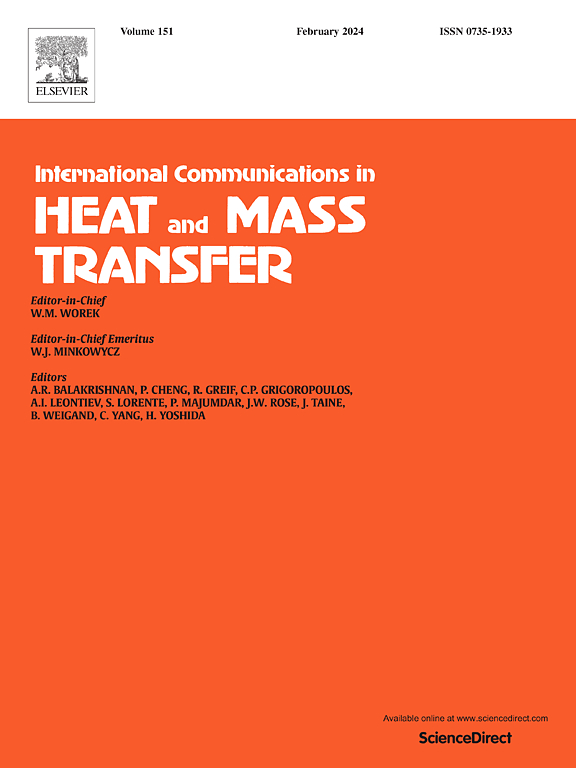Thermal performance of a heat sink (HS)-phase change material (PCM) assisted dual heat pipe (DHP) for LED cooling
IF 6.4
2区 工程技术
Q1 MECHANICS
International Communications in Heat and Mass Transfer
Pub Date : 2025-07-01
DOI:10.1016/j.icheatmasstransfer.2025.109304
引用次数: 0
Abstract
This study evaluates the cooling of 30 W high-power light-emitting diodes (LEDs) using a configuration of LED-heat sink (HS), phase change material (PCM), and dual heat pipe (DHP). Furthermore, it aims to recover HS and DHP from abandoned computers, reduce the thermal resistance between the LED junction and the surrounding air, significantly enhance heat dissipation efficiency, and protect luminous flux. Results show that the average thermal resistance (Rth) values for natural convection and forced convection, measured by the PCM-HS-DHP, were 3.50 and 3.22 °C/W, respectively. LED's maximum junction temperature (Tj,max) is below 113.9 °C and 104.4 °C in natural convection and forced convection, respectively, which meets the requirement of the LED operating below 120 °C. The luminous flux in the forced convection was 3.19 % higher than that in the natural convection, attributed to a lower Tj,max of 8.34 % due to increased heat transfer. This means extending the LED's lifespan. The enhancement ratio (ER) and reduction ratio (RR) values of 2.54 and 5.54, respectively, showed promising outcomes. Reducing the power of the LED, increasing the air velocity, arranging the DHP to draw heat directly from the entire PCM pool or HS base, and increasing the PCM volume can provide better performance and lower Tj,max.

热沉(HS)-相变材料(PCM)辅助双热管(DHP)用于LED冷却的热性能
本研究采用led -散热器(HS)、相变材料(PCM)和双热管(DHP)的配置,对30w大功率发光二极管(led)的散热进行了评估。回收废弃电脑中的HS和DHP,降低LED结与周围空气的热阻,显著提高散热效率,保护光通量。结果表明:PCM-HS-DHP测量的自然对流和强迫对流平均热阻Rth值分别为3.50°C/W和3.22°C/W;LED在自然对流和强制对流下的最高结温(Tj,max)分别低于113.9℃和104.4℃,满足LED在120℃以下工作的要求。强迫对流的光通量比自然对流高3.19%,这是由于Tj较低,最大光通量为8.34%,这是由于传热增加。这意味着延长LED的使用寿命。增强比(ER)和还原比(RR)分别为2.54和5.54,显示出良好的效果。降低LED的功率,增加空气流速,安排DHP直接从整个PCM池或HS基座吸收热量,增加PCM体积可以提供更好的性能和更低的Tj,最大值。
本文章由计算机程序翻译,如有差异,请以英文原文为准。
求助全文
约1分钟内获得全文
求助全文
来源期刊
CiteScore
11.00
自引率
10.00%
发文量
648
审稿时长
32 days
期刊介绍:
International Communications in Heat and Mass Transfer serves as a world forum for the rapid dissemination of new ideas, new measurement techniques, preliminary findings of ongoing investigations, discussions, and criticisms in the field of heat and mass transfer. Two types of manuscript will be considered for publication: communications (short reports of new work or discussions of work which has already been published) and summaries (abstracts of reports, theses or manuscripts which are too long for publication in full). Together with its companion publication, International Journal of Heat and Mass Transfer, with which it shares the same Board of Editors, this journal is read by research workers and engineers throughout the world.

 求助内容:
求助内容: 应助结果提醒方式:
应助结果提醒方式:


